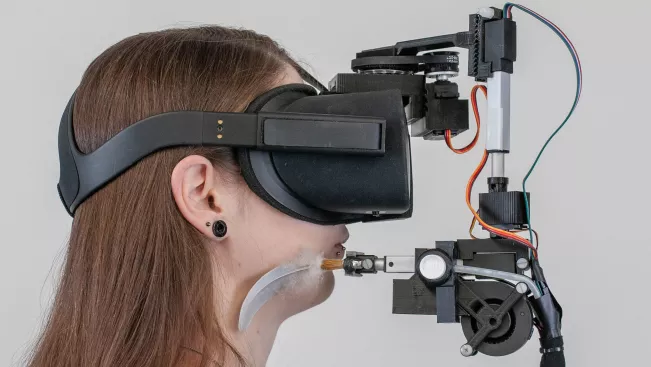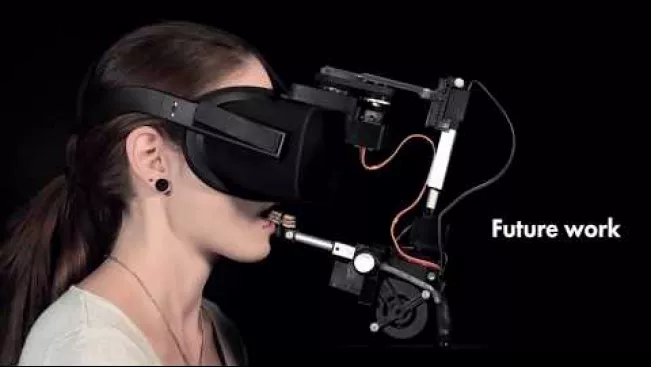Communications and Marketing
FaceHaptics – Simulation for all senses in VR

The FaceHaptics module is based on standard VR glasses, so-called HMDs (head-mounted virtual reality display) and is complemented with a robotic arm designed by the research team led by Ernst Kruijff, Professor of Human Computer Interaction at the Institute for Visual Computing of H-BRS.
The robot arm can be equipped with instruments (actuators) such as fans, heating coils or objects with different textures and is thus able to imitate events within a virtual environment not only visibly and audibly but also tangibly. The novelty of the system is its modularity, flexibility and directionality – the robotic arm can easily be equipped with other actuators to pass on stimuli from different directions towards the user’s face. In addition, the system has a much greater range than actuators built into the HMD – so a larger area of the face can be reached with haptic stimuli. The applications are primarily targeted at the face, which is not usually covered by clothing and has a high number of receptors compared to other areas of the body, what makes it particularly sensitive to external stimuli.

So far studies have predominantly been conducted with soft single – and caressing-touches as well as airflow with different strengths. Only few projects have focused on different textures, spraying with water and the influence of heat. Even more so, in contrast to FaceHaptics, most of these cues only had limited directionality.
Walking through landscapes
The team attempted to demonstrate the extent to which fully-directional haptic stimuli influence the perception of virtual environments. In two studies, the participants crossed a virtual landscape in which either wind direction had to be judged, or emotions were specifically aroused and their perception scaled in a subsequent survey. It turned out that despite of the required equipment and its weight, the general credibility of the simulation increased due to the additional stimuli and a precise spatial location of the stimuli was possible. In addition to that, a higher entertainment value has been indicated by test persons compared to test runs in which the landscape was crossed without additional haptic stimuli. The scientists conclude that due to the higher emotional excitement of the test persons, haptic stimuli can contribute to a higher immersion, an important aspect for especially games but also other types of applications like those used for therapy.
Coming soon
In the next step, the research team would like to improve the system, in particular by reducing the weight of the attached equipment. This should increase comfort and reduce vibrations caused by movements of the robot arm. In addition, the potential of additional components that cause for example slight pain, is being tested to support new gaming experiences.
Sie haben noch Fragen?

Ernst Kruijff
Professor for Human Computer Interaction, Co-Director Institute of Visual Computing (IVC)
Location
Sankt Augustin
Room
C 273
Address
Grantham-Allee 20
53757, Sankt Augustin
Telephone
+49 2241 865 9616Links
Further links